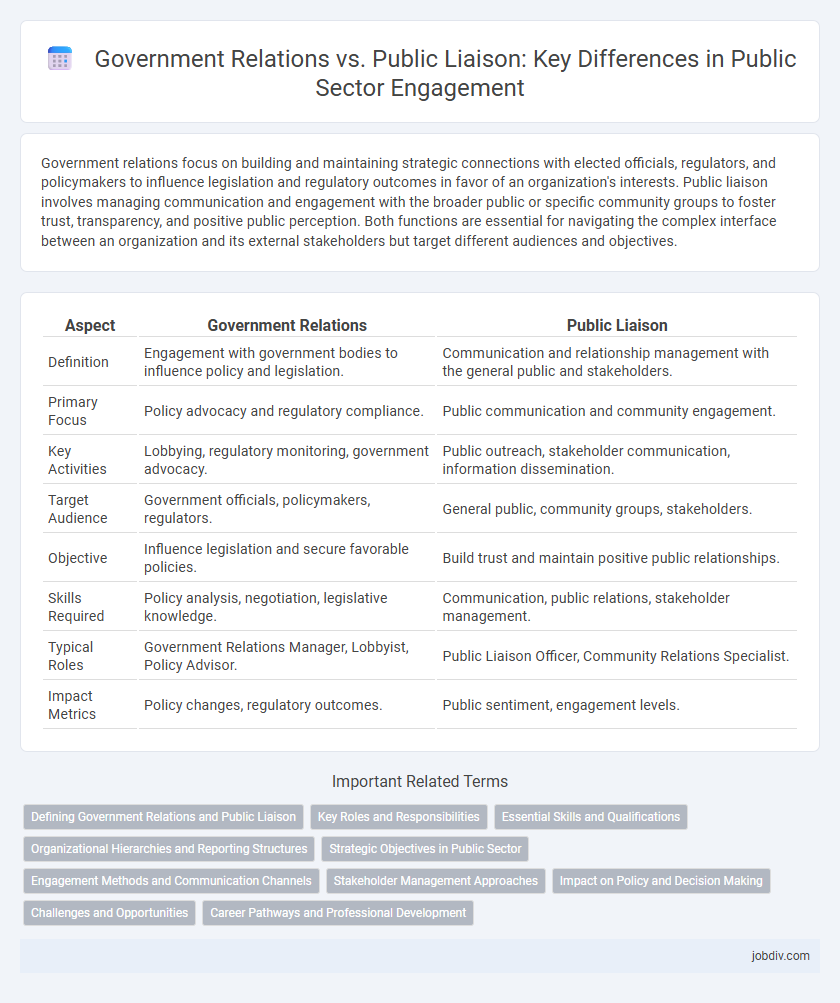Government relations focus on building and maintaining strategic connections with elected officials, regulators, and policymakers to influence legislation and regulatory outcomes in favor of an organization's interests. Public liaison involves managing communication and engagement with the broader public or specific community groups to foster trust, transparency, and positive public perception. Both functions are essential for navigating the complex interface between an organization and its external stakeholders but target different audiences and objectives.
Table of Comparison
| Aspect | Government Relations | Public Liaison |
|---|---|---|
| Definition | Engagement with government bodies to influence policy and legislation. | Communication and relationship management with the general public and stakeholders. |
| Primary Focus | Policy advocacy and regulatory compliance. | Public communication and community engagement. |
| Key Activities | Lobbying, regulatory monitoring, government advocacy. | Public outreach, stakeholder communication, information dissemination. |
| Target Audience | Government officials, policymakers, regulators. | General public, community groups, stakeholders. |
| Objective | Influence legislation and secure favorable policies. | Build trust and maintain positive public relationships. |
| Skills Required | Policy analysis, negotiation, legislative knowledge. | Communication, public relations, stakeholder management. |
| Typical Roles | Government Relations Manager, Lobbyist, Policy Advisor. | Public Liaison Officer, Community Relations Specialist. |
| Impact Metrics | Policy changes, regulatory outcomes. | Public sentiment, engagement levels. |
Defining Government Relations and Public Liaison
Government Relations involves managing interactions between an organization and government bodies to influence public policy and secure favorable regulatory outcomes. Public Liaison focuses on maintaining open communication channels between the government and the public, ensuring transparency and responsiveness. Both roles are essential for fostering collaboration but serve distinct purposes: Government Relations advocates for organizational interests, while Public Liaison facilitates public engagement.
Key Roles and Responsibilities
Government Relations involves managing an organization's interactions with government bodies, focusing on policy advocacy, regulatory compliance, and legislative monitoring to influence public policy and secure favorable outcomes. Public Liaison centers on building and maintaining communication channels between the organization and the public, enhancing community engagement, and managing public perception through outreach initiatives and information dissemination. Both roles require strategic communication skills but differ in target audiences, with Government Relations prioritizing policymakers and Public Liaison emphasizing the broader community.
Essential Skills and Qualifications
Government Relations professionals require strong legislative knowledge, strategic communication skills, and expertise in policy analysis to effectively influence public policy and advocate for organizational interests. Public Liaison specialists excel in stakeholder engagement, public speaking, and community outreach to foster transparent communication between government agencies and the public. Both roles demand critical thinking, negotiation abilities, and a deep understanding of regulatory environments to navigate complex political landscapes.
Organizational Hierarchies and Reporting Structures
Government Relations teams often report directly to senior executives or the legal department, emphasizing strategic policy advocacy and regulatory compliance within organizational hierarchies. Public Liaison roles typically function under communications or public affairs departments, focusing on stakeholder engagement and community outreach with more operational reporting lines. Understanding these distinct reporting structures clarifies how organizations manage external relationships and align their advocacy or engagement efforts.
Strategic Objectives in Public Sector
Government Relations centers on influencing legislation and regulatory frameworks to align with strategic objectives in the public sector, ensuring policy outcomes support institutional goals. Public Liaison focuses on fostering transparent communication and managing stakeholder engagement to build trust and collaboration between government entities and the community. Both functions strategically contribute to effective governance by aligning policy advocacy with public participation and support.
Engagement Methods and Communication Channels
Government Relations employs targeted lobbying, policy advocacy, and regulatory monitoring to influence legislation through direct communication with lawmakers, regulatory agencies, and political stakeholders using formal meetings, policy briefs, and official correspondence. Public Liaison focuses on broader community engagement by organizing town halls, public forums, social media campaigns, and grassroots outreach to foster transparency and gather public input. Both methods utilize tailored communication channels to effectively engage their distinct audiences, with Government Relations emphasizing formal, strategic interactions and Public Liaison prioritizing inclusive, interactive dialogue.
Stakeholder Management Approaches
Government Relations emphasizes direct interaction with policymakers to influence legislation and regulatory decisions, leveraging formal channels for advocacy and negotiation. Public Liaison focuses on engaging a broader range of stakeholders, including community groups and the general public, to build trust and foster positive relationships through transparent communication and outreach. Effective stakeholder management integrates targeted government engagement with inclusive public dialogue to align organizational goals with diverse interests and enhance overall influence.
Impact on Policy and Decision Making
Government relations directly influence policy and decision making by engaging lawmakers, advocating for legislative changes, and providing expert insights that shape regulations. Public liaison focuses on communication and collaboration between the government and the community, facilitating public feedback and ensuring transparency in administrative processes. Effective government relations drive policy formulation, while public liaison ensures community needs and concerns are integrated into government decisions.
Challenges and Opportunities
Government Relations faces challenges in navigating complex regulatory environments and maintaining compliance while leveraging opportunities to influence policy development and secure favorable legislative outcomes. Public Liaison encounters obstacles in managing diverse stakeholder interests and fostering transparent communication, offering opportunities to build trust and enhance public engagement through targeted outreach programs. Both functions require strategic alignment to effectively advocate for organizational goals and respond to evolving public and political landscapes.
Career Pathways and Professional Development
Government Relations professionals specialize in policy analysis, advocacy, and regulatory compliance, often advancing through roles such as legislative assistants or lobbyists, requiring deep knowledge of political processes and legal frameworks. Public Liaison experts build and maintain community engagement and stakeholder relationships, typically progressing through public affairs or communications positions, emphasizing strong interpersonal and media skills. Career growth in both fields benefits from continuous training in public policy, strategic communication, and networking within government and civic sectors.
Government Relations vs Public Liaison Infographic

 jobdiv.com
jobdiv.com